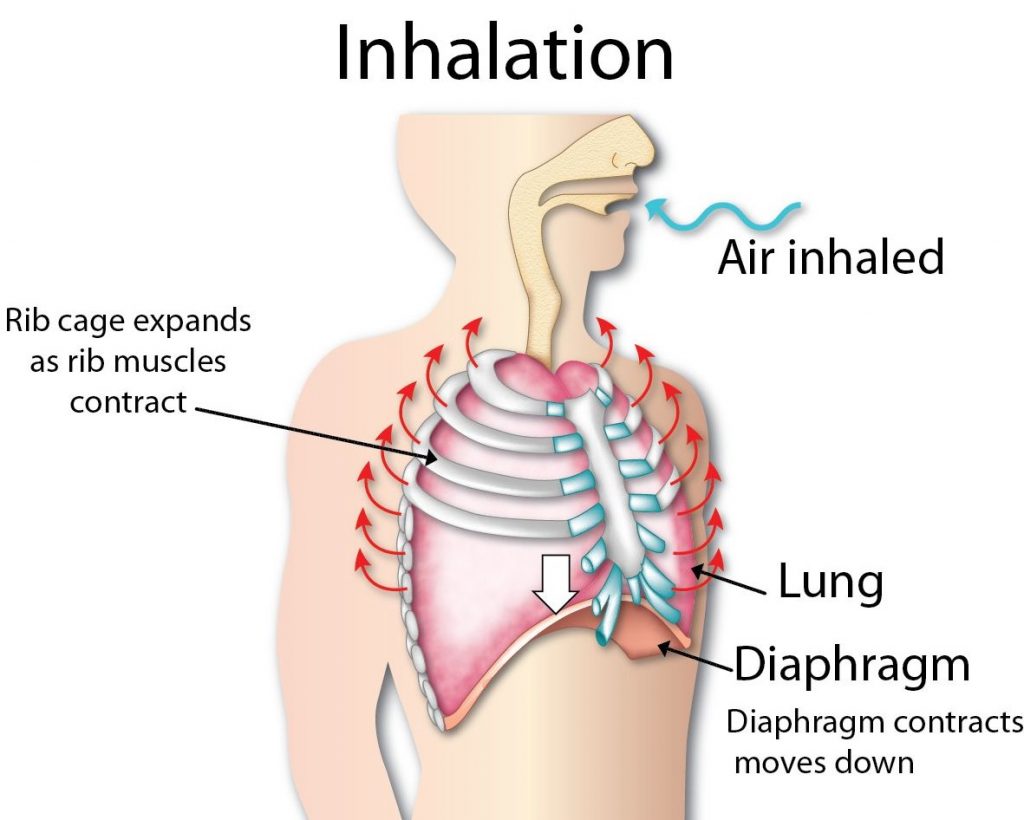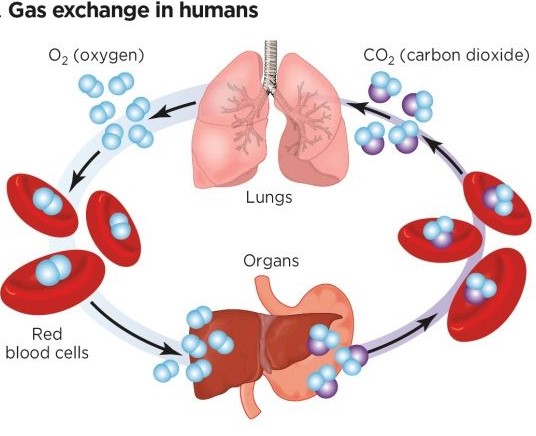Breathing is an essential biological process that sustains life in human beings. It involves the intake of oxygen and the expulsion of carbon dioxide from the body.
What is Breathing?
Breathing is a physiological process that involves the exchange of gases between the body and the external environment. It consists of two main phases- inhalation, where oxygen is taken into the lungs, and exhalation, where carbon dioxide is expelled from the lungs.
3 Important Steps Mechanism of Breathing in Human Beings
Breathing Mechanism in Human Beings involves three following steps-
- Inhalation
- Gaseous exchange
- Exhalation
1. Inhalation

Inhalation Process
Air Intake and Filtration
- Inhalation begins with air entering the body through the nostrils. In the nasal cavity, the air is filtered by hair and mucus, removing particulate matter and warming the air to body temperature.
Path of Air
- After passing through the nasal cavity, the air travels down the pharynx, larynx, and then through the trachea. This pathway serves as the main conduit for the air to reach the lungs.
Chest Cavity Expansion
- The process of inhalation involves the expansion of the chest cavity. This expansion is primarily facilitated by the contraction of the diaphragm, which moves downwards. Simultaneously, the intercostal muscles between the ribs contract, lifting the rib cage upwards and outwards.
Creation of Partial Vacuum
- As the chest cavity enlarges, a partial vacuum is created within it. This vacuum causes a decrease in air pressure inside the lungs compared to the atmospheric pressure outside the body.
Airflow into the Lungs
- Due to the lower pressure inside the lungs, air is drawn in through the nose or mouth to equalise the pressure. As the lungs expand, the air flows through the bronchi and into the bronchioles, finally reaching the alveoli.
Alveoli Expansion
- In the lungs, the inhaled air fills the alveoli, tiny air sacs where the exchange of gases will occur. The expansion of the alveoli is crucial for the efficient uptake of oxygen into the bloodstream.
Also Check- Respiration in Human Beings
2. Gaseous exchange

Oxygen Uptake
- In the alveoli, the process of oxygen uptake is facilitated by the difference in oxygen concentrations. Oxygen from the inhaled air, which is high in concentration within the alveoli, diffuses into the surrounding capillaries. This movement is driven by the lower oxygen concentration in the blood compared to the alveoli.
Carbon Dioxide Release
- Concurrently, carbon dioxide, a waste product of cellular metabolism, is expelled from the body. This gas diffuses from the blood, where its concentration is higher, into the alveoli, where its concentration is lower, ready to be exhaled.
Role of Haemoglobin
- Haemoglobin, the respiratory pigment present in red blood cells, plays a crucial role in this exchange. It binds with oxygen and transports it through the bloodstream to various tissues in the body.
Oxygen and Carbon Dioxide Diffusion in Tissues
- As blood circulates through body tissues, oxygen diffuses from the blood into the cells. Simultaneously, carbon dioxide, produced as a byproduct of cellular respiration, diffuses from the tissues back into the blood.
Carbon Dioxide Transportation to Lungs
- The blood, now carrying carbon dioxide, returns to the lungs. Here, carbon dioxide is released into the alveoli, from where it is expelled during the process of exhalation.
Also Check – Importance Of Respiration
3. Exhalation

3. Exhalation – The Process of Expelling Air from the Lungs
Initiation of Exhalation
- Exhalation begins with the relaxation of the diaphragm and intercostal muscles. This relaxation reduces the volume of the chest cavity.
- The diaphragm becomes dome-shaped, and the ribs move downward as they contract, contributing to the decrease in lung volume.
Increase in Lung Pressure
- As the lung volume decreases, the pressure inside the lungs increases. This increase in pressure creates a gradient where the lung pressure is higher than the atmospheric pressure.
Air Expulsion and Carbon Dioxide Elimination
- The higher pressure inside the lungs forces air out of the lungs. This expelled air contains carbon dioxide, a waste product of cellular metabolism.
- Carbon dioxide, transported from various parts of the body to the lungs via the blood, is released into the alveoli and then expelled from the body during exhalation.
Compression of the Chest Cavity
- The relaxation of the ribs and diaphragm leads to a compression of the chest cavity, further facilitating the expulsion of air.
- The movement of the ribs and diaphragm is crucial in creating the necessary pressure differential for air to be pushed out into the atmosphere.
Also Check- Role of Respiratory Pigment in Respiration
Also Check – 9 Important Differences Between Inhalation and Exhalation


3 Comments on “Explain the Mechanism of Breathing in Human Beings”